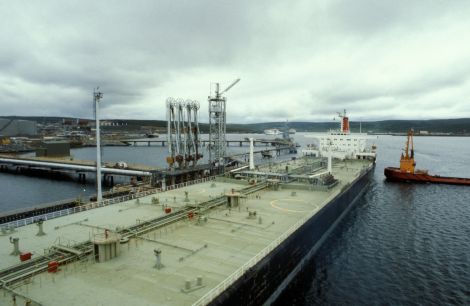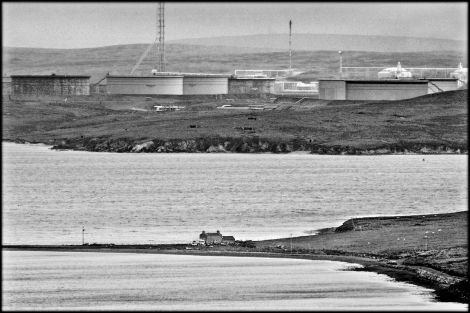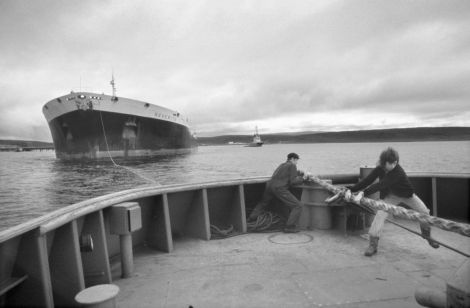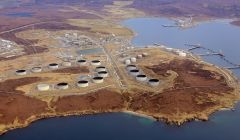Business / Forty years and counting for oil at Sullom Voe
Shetland changed forever exactly 40 years ago this Sunday.
IT WAS on 25 November 1978 when the first barrel of oil came ashore at Sullom Voe Terminal from the Dunlin field via the Brent pipeline.
The first appearance of black gold was the culmination of years of work that saw thousands of people – including droves of incomers from the UK mainland and beyond – employed on site in one of Europe’s largest construction projects.
Tucked away between Toft and Sullom, the terminal continues to outlive its initial anticipated lifespan of around 25 years and although today much quieter, the facility has so far produced 8.3 billion barrels of oil.
Days after the first oil more of the black stuff was taken in through the Ninian pipeline before the terminal, which covers 1,000 acres, was formally opened by the Queen in 1981.
That launch ceremony, though, saw a bomb detonated by the Provisional IRA in the power station in a failed bid to assassinate the monarch, with no injuries reported.
The building of the terminal transformed nearby villages of Brae and Mossbank, with the populations soaring to accommodate staff. Highlighting the sheer magnitude of the project, the construction workforce peaked at over 7,000.
Accommodation camps were erected at Toft and Firth, complete with bars to give visiting workers – mainly men – a chance to unwind, while ferries such as the Rangatira and the Stena Baltica were also used when space ran out.
Construction workers – known then as ‘bears’ – were bussed back and forth, with the north mainland of Shetland becoming a hive of activity never seen before in the isles.
Shetland brought into the limelight
It was a melting pot of cultures as people from all corners of the UK, as well as the likes of Ireland, came to work in Shetland as the remote and rural islands were thrust into the national – and international – limelight.
Become a member of Shetland News
Some saw it as a threat to Shetland’s way of life, which had revolved around traditional industries like crofting and fishing, but its knock-on effect to the local economy was substantial.
Shetland’s population had fallen to almost 17,000 in the mid-1960s, but it rose by nearly one third between 1971 and 1981 due to the oil activity. In between this Scatsta Airport – previously used by the RAF during World War II – was reinstated to support the burgeoning North Sea oil industry, providing extra local employment.
Many of the incoming workers left Shetland after the construction was completed and will have never set foot in the isles again, but many stayed, starting families and embedding themselves into the local communities.
To mitigate the local impact, a landmark deal was struck which saw money paid to the community from the oil industry, leading to Shetland Charitable Trust, which is today sitting on reserves of over £300 million.
The money was used on projects like building leisure centres across the isles – giving residents of northerly island Unst, for instance, their own swimming pool – but purse strings have since tightened.
The first oil had been a long time coming. The initial exploration phase for oil and gas off Shetland started in 1970, with the laying of the pipelines and the terminal construction taking place five years later.
The first oil was shipped out of the terminal on the Shell tanker Donovania five days after the first arrival.
Millions of barrels a week
At its peak in the 1980s, the terminal was processing over 1.5 million barrels of oil a day and by 1997 the six billionth barrel of crude oil was produced at the terminal, highlighting the importance the facility had to the UK economy.
In 1986 over 650 tankers used the port of Sullom Voe, but that number steadily decreased ever since, with only 63 crude oil export tankers using the port in 2017/18.
The construction of the nearby Shetland Gas Plant in the 2010s echoed the oil boom of the 1970s to an extent, but the 700-strong workforce involved was a far cry from the thousands-strong influx for the terminal.
Today the ageing terminal is a different proposition that what it was back in 1978, with the takeover by EnQuest last year pointing towards cost-cutting and streamlining.
It now receives production from more than 30 fields from the Brent, Ninian, Shetland Gas Plant and Clair pipeline systems and last Thursday there were just over 470 people working on site, blending together staff members and contractors.
Managing director of North Sea for EnQuest Bob Davenport said it was important to mark the 40th anniversary milestone and to “recognise the positive contribution by the terminal and by all the men and women who have worked there during these past four decades”.
“This has created tremendous value for the economy and for the citizens of the United Kingdom via jobs, tax revenue benefits and by enabling the many supporting business activities right across the sector,” he said.
Davenport said that “we expect to be producing oil for another 40 years in the neighbourhood – so our future is bright if we can continue our journey to transform the terminal to remain competitive”.
“While we’re really optimistic about the future at SVT, knowing how much remaining oil and gas is to be extracted in the region, it’s an opportunity – but it’s not a guarantee,” he continued.
“We understand that we’ve got to compete for the business in the future, and we must be competitive in order to create the opportunity for SVT to be a viable business for the next 40 years.”
A time of transition
Craig Lennox, who joined EnQuest as the terminal’s general manager in September, reiterated that the company needs to provide a “cost effective solution for customers” at the same time as transitioning plant and equipment to cater for changing demands.
Operating costs at the terminal have been reduced from £200 million in 2017 to around £150 million this year.
“We’re trying to lift our heads to look at it as a mid-life asset as opposed to talking about it as a late life asset,” Lennox said.
“That therefore then I think breeds a kind of different feeling with both the employees and customers and suppliers, and as stakeholders we’re working very closely with Shetland Islands Council and the OGA [Oil and Gas Authority] because we recognise that we don’t have all the answers, and some of the future customers we don’t even yet know.”
The long-term future of the terminal may be somewhat speculative, although Friday’s news of oil being produced from Clair Ridge is a boost in the right direction. What is not unclear, however, is the impact the industry has had on Shetland.
One of the main beneficiaries has been Shetland Islands Council, with the oil boom allowing the local authority to invest more in services.
“Since its construction, the impact of Sullom Voe Terminal has been transformational for Shetland,” council convener Malcolm Bell said.
“The step-change it created has helped the council provide and sustain services and infrastructure which, would be the envy of local authorities elsewhere as well as being an important factor in maintaining and developing Shetland’s vibrant economy.
“The terminal’s lifespan has extended well beyond initial expectations and I hope this unique partnership, between the council and the oil industry, will continue for many years to come.”
Read the recollections of staff at www.shetnews.co.uk/2018/11/23/the-early-days-of-sullom-voe-in-their-own-words/
Become a member of Shetland News
Shetland News is asking its many readers to consider paying for membership to get additional features and services: -
- Remove non-local ads;
- Bookmark posts to read later;
- Exclusive curated weekly newsletter;
- Hide membership messages;
- Comments open for discussion.
If you appreciate what we do and feel strongly about impartial local journalism, then please become a member of Shetland News by either making a single payment, or setting up a monthly, quarterly or yearly subscription.















































































